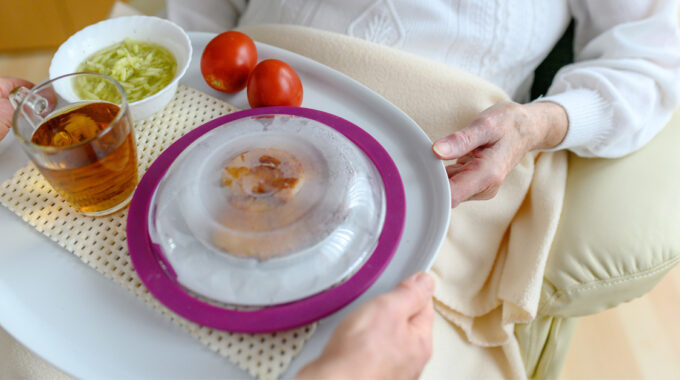
Elderly Malnutrition: Common, Costly, and Dangerous
The elderly suffer from malnutrition more than many people realize. Studies have measured the prevalence of malnutrition among the elderly between 17% and 65% – depending on the groups being measured and the settings.1 Patients discharged from rehab facilities, long-term care residents, and elderly requiring a higher level of care make up the upper end of that range. Despite how common malnutrition is among our elderly, we should take it seriously. Malnutrition among retirees has been connected with increased hospitalization, falls, hip fractures, depression, poor quality of life, and increased mortality.2-5 Fortunately, a new study demonstrates how easy it can be to reverse malnutrition with a little help, especially when that help comes from home health agencies.
What Is Malnutrition?
The Academy of Nutrition and Dietetics defines malnutrition simply as any imbalance in calories, protein, vitamins, minerals, or other nutrients.6 Malnutrition includes overnutrition, but most people use the term to refer to undernutrition. The condition reaches clinical importance when any body function becomes impaired.
Signs of Malnutrition
- Low body weight
- Tiredness
- Bad moods
- Reduced cognitive function
- Changes in the face, eyes, skin, nails, and teeth
- Signs of physical wasting
- Changes in bowel function such as constipation
The Journal of Nutrition, Health & Aging (2018)7
Risk Factors Signaling Possible Malnutrition
- Without reason, has lost more than 10 lbs. in the last 3 months
- Has an illness or condition that makes him / her change the type of and / or amount of food eaten
- Has an open decubitus ulcer, burn, and/or wound
- Eats fewer than 2 meals per day
- Has a tooth / mouth problem which makes it hard to eat
- Has 3 or more drinks of beer, liquor, or wine almost daily
- Does not always have enough money to buy food if needed
- Eats few fruits or vegetables or milk products
- Eats alone most of the time
- Takes 3 or more prescribed or OTC medications daily
- Is not always physically able to cook and / or feed self and has no caregiver assisting
- Frequent problems with diarrhea or constipation
Journal of Parenteral and Enteral Nutrition (2020)8
A Little Help Can Fix Malnutrition
The Journal of Parenteral and Enteral Nutrition published a study earlier this year showing how a very simple nutrition program conducted by home health nurses improved patient health.8 When new patients showed a few of the risk factors above, nurses started teaching them about nutrition and coaching them to drink meal supplement drinks. The home health agencies supplied either 60 bottles of Ensure, 60 bottles of Glucerna, or 30 bottles of Nepro. Compared with home health patients from the prior year who did not have the same intervention, the nutrition program reduced hospitalizations 24% and lowered three-month medical costs $1,500 per patient!
References
- Isenring E, Banks M, Ferguson M, et al. Beyond malnutrition screening: appropriate methods to guide nutrition care for aged care residents. J Acad Nutr Diet. 2012;112: 376-381.
- Pirlich M, Schutz T, Norman K, et al. The German hospital malnutrition study. Clin Nutr. 2006;25 (4): 563-572.
- Thomas J, Isenring E, Kellett E. Nutritional status and length of stay in patients admitted to an acute assessment unit. J Hum Nutr Diet. 2007;20(4):320-328.
- Visvanathan R, Penhall R, Chapman I. Nutritional screening of older people in a sub-acute care facility in Australia and its relation to discharge outcomes. Age Ageing. 2004;33(3):260-265.
- Correia J, Martins C, Amaral T. Efficiency of MST-Malnutrition Screening Tool in elderly hospitalized patients. Clin Nutr. 2003;22 (suppl 1): S10.
- White JV, Guenter P, Jensen G, Malone A, Schofield M, Group AM, Force AM, of Directors AB. Consensus statement of the Academy of Nutrition and Dietetics/American Society for Parenteral and Enteral Nutrition: characteristics recommended for the identification and documentation of adult malnutrition (undernutrition). Journal of the Academy of Nutrition and Dietetics. 2012 May 1;112(5):730-8.
- Craven DL, Lovell GP, Pelly FE, Isenring E. Community-living older adults’ perceptions of body weight, signs of malnutrition and sources of information: a descriptive analysis of survey data. The Journal of Nutrition, Health & Aging. 2018 Mar 1;22(3):393-9.
- Riley K, Sulo S, Dabbous F, Partridge J, Kozmic S, Landow W, VanDerBosch G, Falson MK, Sriram K. Reducing Hospitalizations and Costs: A Home Health Nutrition‐Focused Quality Improvement Program. Journal of Parenteral and Enteral Nutrition. 2020 Jan;44(1):58-68.






